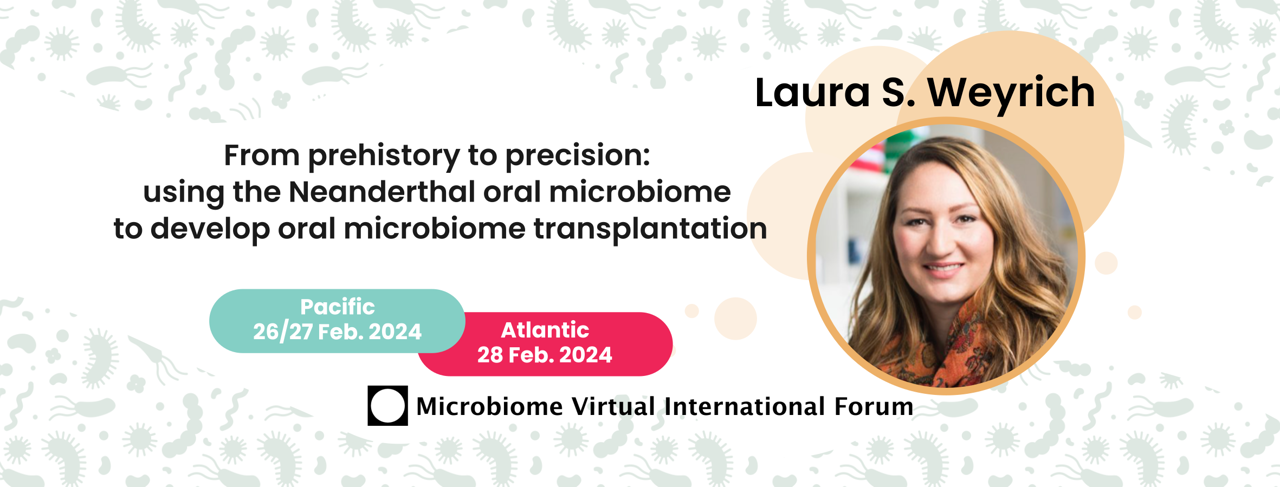From prehistory to precision: using the Neanderthal oral microbiome to develop oral microbiome transplantation
by prof. Laura S Weyrich
Short Bio
Dr. Weyrich received a PhD in Microbiology and Bioethics from Penn State, and in 2012, she completed a post-doc and established her own research team at the University of Adelaide. In 2019, Dr. Weyrich moved to Penn State University to lead a new ancient DNA initiative there. The cornerstone of her research is using calcified dental plaque to reconstruct ancient human oral microbiomes. Her team was the first to reconstruct the microbiome of an extinct species - Neandertals - and has reassembled one of the oldest microbial genomes to date at 48,000 years old. Her team’s research has been featured by the BBC, NPR, Science, Nature, New Scientist, NY Times, Smithsonian Magazine, National Geographic, and many others, and has even had a Buzz Feed quiz written about it. Her team is now reconstructing the evolutionary history of the human oral microbiome on six continents, leveraging the information from our ancestors to improve our health today.
Short talks
Effective binning of metagenomic contigs using contrastive multi-view representation learning
Contig binning plays a crucial role in metagenomic data analysis by grouping contigs from the same or closely related genomes. However, existing binning methods face challenges in practical applications due to the diversity of data types and the difficulties in efficiently integrating heterogeneous information. Here, we introduce COMEBin, a binning method based on contrastive multi-view representation learning. COMEBin utilizes data augmentation to generate multiple fragments (views) of each contig and obtains high-quality embeddings of heterogeneous features (sequence coverage and k-mer distribution) through contrastive learning. Experimental results on multiple simulated and real datasets demonstrate that COMEBin outperforms state-of-the-art binning methods, particularly in recovering near-complete genomes from real environmental samples. COMEBin outperforms other binning methods remarkably when integrated into metagenomic analysis pipelines, including the recovery of potentially pathogenic antibiotic-resistant bacteria (PARB) and moderate or higher quality bins containing potential biosynthetic gene clusters (BGCs).
Link to OA paper: https://www.nature.com/articles/s41467-023-44290-z
Ziye Wang
Fudan University, China
BMI and BPH correlate with urinary microbiome diversity and lower urinary tract symptoms in men
Several studies have identified bacteria and other microbes in the bladder and lower urinary tract in the absence of infection. In women, the urinary microbiome has been associated with lower urinary tract symptoms (LUTS) such as urge urinary incontinence. However, similar studies have not been undertaken in large cohorts of men. Here we examine the urinary microbiome and its association with LUTS in a subset of 500 men aged 65 to 90 years from the Osteoporotic Fractures in Men (MrOS) study. We identified significant associations between benign prostatic hyperplasia (BPH), age, and body mass index (BMI) with several diversity metrics. Our analysis revealed complex relationships between BMI, BPH, LUTS, and alpha diversity which give insight into the intricate dynamics of the urinary microbiome. By beginning to uncover the interrelationships of BPH, BMI, LUTS, and the urinary microbiome, these results can inform future study design to better understand the heterogeneity of the male urinary microbiome.
Kate Bowie
Yale University, USA
Pervasive selective sweeps across human gut microbiomes
The human gut microbiome is composed of a highly diverse consortia of species which are continually evolving within and across hosts. The ability to identify adaptations common to many host gut microbiomes would not only reveal shared selection pressures across hosts, but also key drivers of functional differentiation of the microbiome that may affect community structure and host traits. However, to date there has not been a systematic scan for adaptations that have spread across host microbiomes. Here, we develop a novel selection scan statistic, named the integrated linkage disequilibrium score (iLDS), that can detect the spread of adaptive haplotypes across host microbiomes via migration and horizontal gene transfer. Specifically, iLDS leverages signals of hitchhiking of deleterious variants with the beneficial variant, a common feature of adaptive evolution. We find that iLDS is capable of detecting simulated and known cases of selection, and moreover is robust to potential confounders that can also elevate LD. Application of the statistic to ∼20 common commensal gut species from a large cohort of healthy, Western adults reveals pervasive spread of selected alleles across human microbiomes mediated by horizontal gene transfer. Among the candidate selective sweeps recovered by iLDS is an enrichment for genes involved in the metabolism of maltodextrin, a synthetic starch that has recently become a widespread component of Western diets. In summary, we demonstrate that selective sweeps across host microbiomes are a common feature of the evolution of the human gut microbiome.
Link to OA paper: https://www.biorxiv.org/content/10.1101/2023.12.22.573162v1
Richard Wolff
UCLA, USA
Viroid-like colonists of human microbiomes
Here, we describe the “Obelisks,” a previously unrecognised class of viroid-like elements that we first identified in human gut metatranscriptomic data. “Obelisks” share several properties: (i) apparently circular RNA ∼1kb genome assemblies, (ii) predicted rod-like secondary structures encompassing the entire genome, and (iii) open reading frames coding for a novel protein superfamily, which we call the “Oblins”. We find that Obelisks form their own distinct phylogenetic group with no detectable sequence or structural similarity to known biological agents. Further, Obelisks are prevalent in tested human microbiome metatranscriptomes with representatives detected in ∼7% of analysed stool metatranscriptomes (29/440) and in ∼50% of analysed oral metatranscriptomes (17/32). Obelisk compositions appear to differ between the anatomic sites and are capable of persisting in individuals, with continued presence over >300 days observed in one case. Large scale searches identified 29,959 Obelisks (clustered at 90% nucleotide identity), with examples from all seven continents and in diverse ecological niches. From this search, a subset of Obelisks are identified to code for Obelisk-specific variants of the hammerhead type-III self-cleaving ribozyme. Lastly, we identified one case of a bacterial species (Streptococcus sanguinis) in which a subset of defined laboratory strains harboured a specific Obelisk RNA population. As such, Obelisks comprise a class of diverse RNAs that have colonised, and gone unnoticed in, human, and global microbiomes.
Link to OA paper: https://www.biorxiv.org/content/10.1101/2024.01.20.576352v1
Ivan Zheludev
Stanford University, USA

